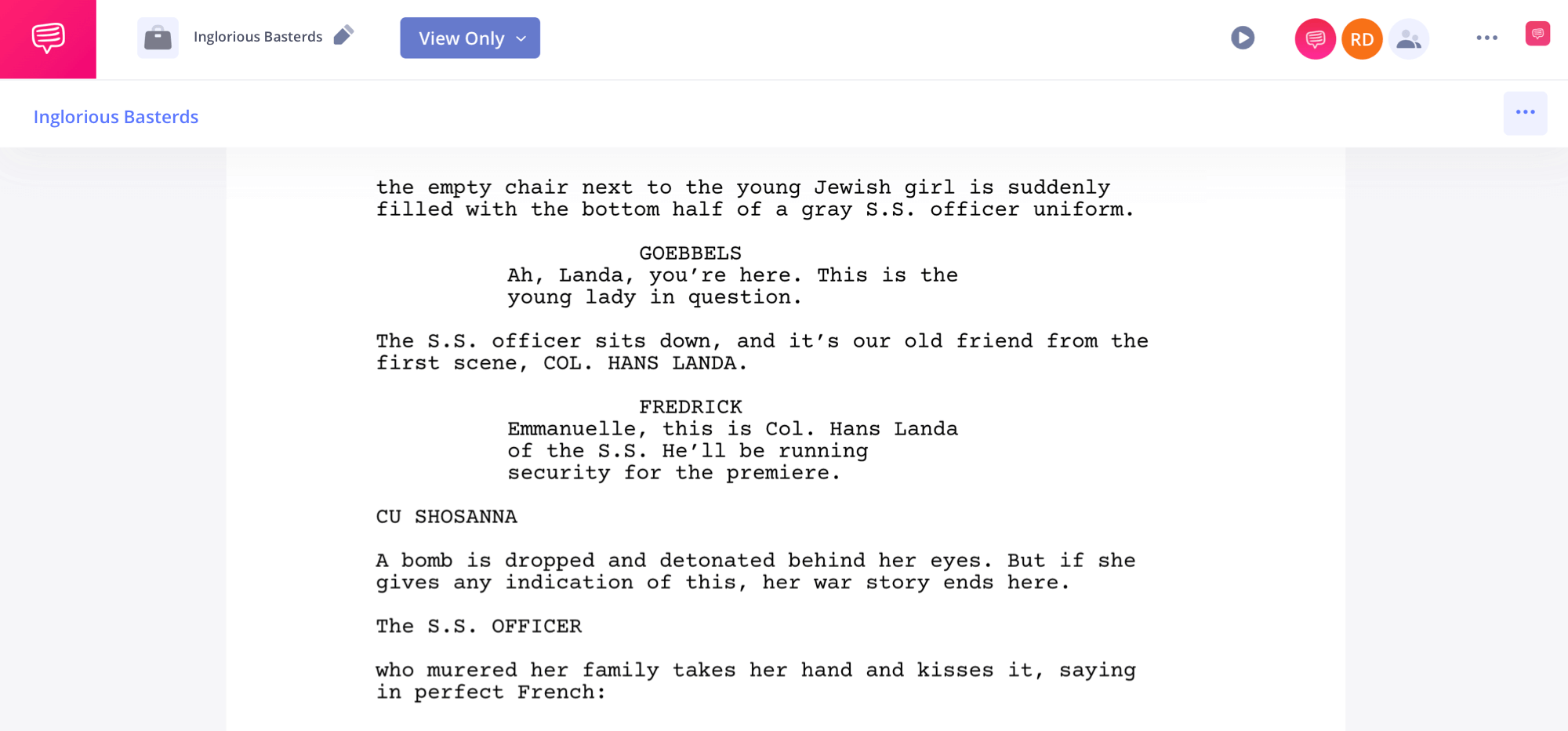There are novels and screenplays you read as a spectator, distanced from the story happening, only peering in from afar. Then there are pieces of art you experience. It reaches deep inside you, inviting and allowing you to be a part of the story. The difference between the two is influenced by how the piece tells the story. Specifically, in the way it uses the technique of “show, don’t tell” writing.
Guide to Show Don’t Tell Writing
First, let’s define show don’t tell writing
Show don't tell writing is more of a principle than it is a rule. It's a guiding mentality toward writing as a craft, challenging easier writing methods for better technique.
SHOW DON’T TELL WRITING MEANING
What is show don’t tell writing?
"Show don't tell" is a writing technique where the writer conveys ideas, emotions, and scenes through sensory details, actions, and dialogue rather than straightforward exposition. It's a common technique in screenwriting and fiction writing. It's a common piece of advice for new and seasoned writers because of its ability to engage a reader and invite them to actively participate in experiencing a story than just being told a story.
Telling: John was nervous.
Showing: John's hands trembled as he reached for the microphone, his breath quickening.
The first example simply tells us John's emotional state, while the second shows it through his physical reactions.
Why is show don’t tell writing important?
- Engages readers
- Creates immersion
- Deepens emotional connection
Show Don’t Tell Examples
Why Show Don't Tell Is Important
Showing rather than telling creates a deeper connection between the reader and the story. It can be the difference between a reader experiencing the emotions and headspace of a character and them simply watching as a spectator the events of a story.
The best way to understand the importance of show don't tell writing is through an example by a great writer. So we brought Quentin Tarantino's Inglorious Basterds screenplay into the StudioBinder screenwriting app to analyze how he shows the emotional state of his characters through action rather than simply telling us how they are feeling.
Let's take for example, the way Tarantino describes the reaction of Shoshana when she meets the man who murdered her family, Colonel Hans Landa.
Inglorious Basterds (2009)
Tarantino writes:
“A bomb is dropped and detonated behind her eyes. But if she gives any indication of this, her war story ends here.”
To describe to us both the emotion of Shoshana and the stakes of her revealing these emotions, QT uses the visceral description and metaphor of a bomb. He shows us, through great screenwriting, the emotion that is occurring in Shoshana as she shakes the hand of Landa.
Within both cinema and literature, writers can benefit from ‘show don’t tell writing’ when delivering exposition. Exposition can be incredibly important for setting up the story for your audience. But all too often it's done poorly, spoon feeding information to audiences directly. This disengages an audience, as they aren’t required to lean in and decipher information.
Instead, showing elements in your story that deliver this exposition can invite them to analyze and interpret what these elements say about a character or story.
What is Exposition in Screenwriting • Subscribe here
It can be easier to write your story by telling your audience key pieces of information directly. But it will inevitably make your writing weaker over time. Practicing ways to show rather than tell your story can be the best way to hook them into your narrative world. Let’s look at how to do this.
Show Don’t Tell Technique Significance
Tips for Show Don't Tell Writing
It's easy to tell a writer to show rather than tell, but executing this in a way that tells your story and captivates your readers can be a challenging task for writers of all experiences. As a writer, the more you write the more you will find your own voice and style. But along the way there are a few aspects of show don't tell writing to keep in mind.
This complete writing guide video by Diane Callahan is a great start to understanding the value of show don’t tell writing and how to use it well.
How to Show, Not Tell: The Complete Writing Guide
Let’s recap a few points and tips to ‘show don’t tell writing’.
Use Sensory Details
Engage the reader's senses by describing what characters see, hear, smell, taste, and touch. Sensory details bring scenes to life and make them more relatable. A part of the human experience (for most people) is the ability to experience the world through at least some or all of these senses.
Writing descriptively about what your character sees, touches, hears, feels, tastes, and smells creates an experience for a reader in the same way they experience the real world. Some of the best writers appeal to the senses in this way, rather than using vague descriptions.
This also allows readers to interpret how characters feel about these things and the world around them rather than being told how the characters feel.
Reveal Character Through Action
When it comes to character, a common mistake is telling a reader directly about a character and who they are through an expositional word vomit. A better way to reveal characters is to reveal their personality through actions and reactions.
Callahan refers to this as using evidence to support a claim. For characters, evidence of a claim is more often than not found in their actions and behavior. What does a character do that supports what you are telling the reader about them?
The world of your story, other characters, and the circumstances you create will cause your character to react and make behavioral decisions. This is how the reader should learn more about your character.
An elderly woman stands waiting for the bus as it rains. Your character walks by with an umbrella. What do they do as they see this woman?
Your character is in an elevator alone and sees a business man running to make the elevator. The doors begin to close. Does your character hold the elevator door?
While these are seemingly mundane daily interactions, you can see how their actions and reactions to even simple things can reveal a lot about their personality.
Show Internal State of Mind
A part of experiencing a story is understanding the internal state of mind of a story's central characters. Whether it's succumbing to madness, falling in love, or relentless dedication to a goal, a character's psyche can be difficult to write using show don't tell writing. How do you tell a reader what a character is going through in their mind without directly telling them?
Again, action and behavior will tell your reader more about your character in a more engaging way than any direct exposition.
Rather than telling your reader a character is depressed, describe how they get up late in the afternoon and struggle to find the energy to even take a shower and eat a proper meal.
If a character is in love, don't just tell the reader they are smiling on their first date because they have fallen in love. Tap into your emotions and describe the details — how her heartbeat gets faster and faster, how she forgets that there are other people in the restaurant and how time seems to move both fast and stand still.
Create Vivid Descriptions
Exposition can be boring and disengaging when done poorly. Telling a reader the backstory of a character or describing the facts about a setting can cause them to lean back and disengage with a story. However, using vivid descriptions of setting and characters can invite readers to piece together these visuals and what they think it means to a story.
Rather than telling the reader that a character is a varsity football athlete with dreams of becoming an olympian, show them the medals and trophies in their bedroom and the posters of Olympic athletes on his wall.
Use Figurative Language
Figurative language can add depth and meaning to your writing in fewer words than blatant exposition. Like imagery, metaphors and simile have an emotional impact behind them and have the ability to take a visual description and create deeper meaning about a story thematically.
What is a Metaphor? • Subscribe here
While "show don't tell" is a valuable technique, it's essential to balance it with necessary exposition. Overloading your writing with descriptions can slow down the pace of your writing and run the risk of watering down your story with too much detail. It’s all about balance — tell and show in a way that best tells your story.
What is Story Structure?
Another key component of great writing is structure. Understanding story structure will allow you to tell your story in the most engaging way possible. Learn more about story structure in our next read.

